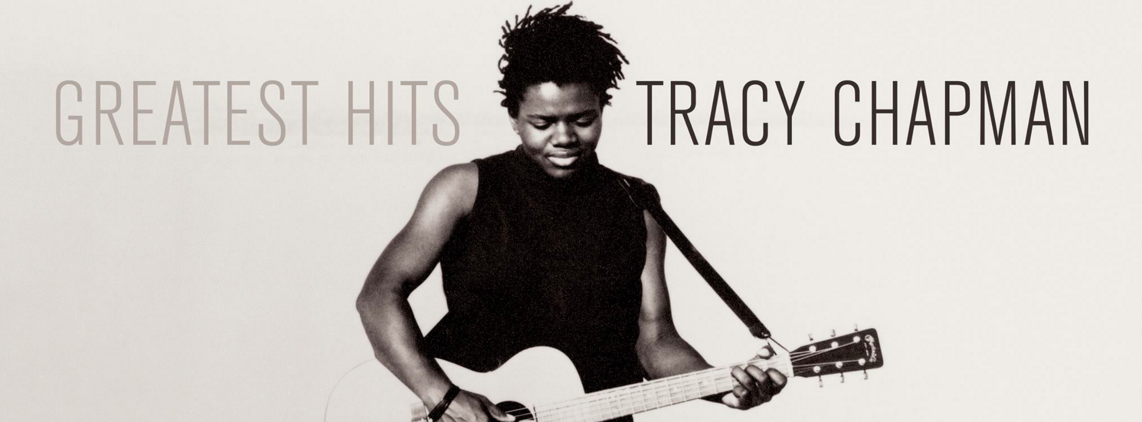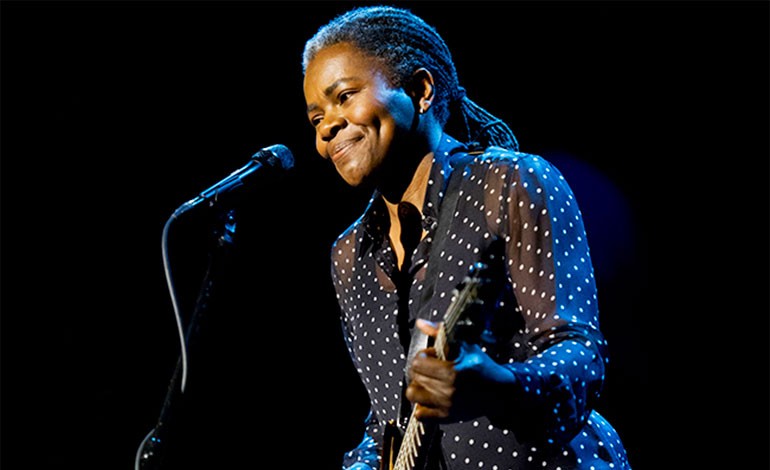By Ariel Swartley, New York Times, April 2, 2000
LOS ANGELES — NOONTIME in the walled garden of the Chateau Marmont, the funkily chic Sunset Strip hotel long associated with Hollywood’s ancien rock ‘n’ roll regime, where the paradisiacal perfection of warm sun, lush greenery and aged concrete is marred only by a venomous Santa Ana wind. In sturdy brogues and a boxy sweater over jeans and a tee, the singer-songwriter Tracy Chapman looks light years more wholesome than some of the hotel’s famously dissipated guests and considerably less self-conscious than the party of kohl-eyed post-punks chatting in a nearby nook.
Here to rehearse for her forthcoming tour (she performs at Roseland in Manhattan on Tuesday) and to shoot a video for ”Telling Stories,” the title song from her fifth album, Ms. Chapman, 35, is still marveling over the mechanics of illusion that the video process revealed. There was the oddity of seeing a full-size bus on a sound stage and the man ”with these massive legs,” sitting ”with his foot on a pole that was leveraged underneath a back corner,” whose job was to rock the bus so it seemed to be moving. The explanation is interrupted by movement that’s all too real — a sudden gust tears through the garden, nearly upending the skirts of the nearest patio umbrella and leaving it teetering.
When a waiter approaches, Ms. Chapman, who lives in San Francisco where the winds, at least, are more predictable, gestures to the umbrella: ”Can I ask you a question? Is this secure, right here?”
The young man answers with the confiding tone (he might be imparting the name of Mick Jagger’s chiropractor) and studied vagueness that Angelenos — especially those in or near the entertainment industry — are famous for: ‘‘Who knows? The wind is kind of blowing. Do you want me to put it down?’‘
”No,” she said, ”but we cranked it up and didn’t know if it had some sort of locking mechanism.” Ms. Chapman’s speaking voice, which retains the practical twang of her Ohio childhood, registers the precise terminology as cleanly as black type on a white page.
Checking the umbrella, the waiter reports — his delivery now crisp, his language, under the influence of his questioner’s, newly specific — that the device ”is locked and secure.”
It’s a one-minute lesson — especially enlightening in the city where image is thought to rule — of the power of words to order the world.
Ms. Chapman’s mastery of a number of different vocabularies has been evident since her first album, ”Tracy Chapman,” was released in 1988. A graduate of the Wooster School in Connecticut and Tufts University in Massachusetts, she wrote songs from the perspectives of checkout girls, convicts and runaways. A black woman who grew up in a working-poor, single-parent household in Cleveland, she sang in an alto that eschewed the growl-and-moan drama of blues, soul and gospel in favor of the self-effacing delivery beloved by decades of privileged white Cambridge folkies. And though as a performer she seemed grateful to have a guitar to bury herself in, her lyrical stance was forthright, even polemical (”Poor people gonna rise up/ And take what’s theirs.”)
”Tracy Chapman” won three Grammys and catapulted the studious young woman (who recalls taking ”every ethno-musicology course that was available” at Tufts, including West African drumming and Japanese classical music, and who was for a time considering a graduate degree) onto a decidedly uncontemplative treadmill of touring and recording. Not surprisingly, songs on subsequent albums — ”Crossroads,” ”Matters of the Heart” and ”New Beginning” — began to show the strain of what she describes as ”not having a moment to sit and play without any particular goal in mind.” Rhetoric became a substitute for the focused demands of storytelling.
Nowhere, however, is Ms. Chapman’s concern for precision more noticeable than on ”Telling Stories,” her first recording in five years. ”There was pressure,” she admits, to return to the studio sooner, but she resisted — wisely, it appears. Indeed, if albums were dresses, then the difference between 1995’s ”New Beginning” and this one could be described as the difference between a gauzy patchwork jumper and a couture sheath. On the earlier album, her generally spare melodies were draped with colorful swaths of instrumentation — cello, Scottish small-pipes, multiple keyboards. Lyrics, too, tended to the loose and flowing. And not even a singer as warmly empathetic as Ms. Chapman could make a line like ”we create the pain and the suffering and the beauty in this world” lose its didactic edge.
In contrast, the overall effect of the 11 songs on ”Telling Stories” — first-person narratives all — is one of almost severe design. Uncluttered guitar lines set off a single word or phrase like ”devotion” or ”if I’d lived right” and then turn it and return to it to display subtle shades of meaning. The album’s mood might be described as sober but glowing. Lines like ”speak the word” or ”keep the walls from falling down” have biblical echoes, but Ms. Chapman’s doctrine is emphatically secular: ”let me speak the word” and ”I keep the walls from falling down.” In what may be the record’s most poignant line, sung in silver-toned harmony with Emmylou Harris, she asks, ”Does heaven have enough angels yet?”
While the personal predominates, the political has not been overlooked. In truth, poverty and racism, Ms. Chapman’s longtime concerns, show up all the more starkly in these minimalist settings: ”Learned not to believe/ This is as good as it gets/ Because we ain’t seen nothing yet.” At the same time there is a rhythmic pulse to the songs — a syncopation evocative of the short steps and long of older dances, waltzes and fox trots, in which partners haltingly, perhaps, but good-humoredly, try to accommodate each other — a pulse that pins a joyous train on the album’s serious reflections.
Admittedly, mentioning Ms. Chapman and dresses in the same sentence is something of a leap. On her albums, she has displayed a decided preference for vests and jeans. But the impulse to equate maturity with studied simplicity — the same impulse that leads fashion followers sighting 40 to embrace Armani and rediscover the allure of welted seams — affects artists, too.
And like Joni Mitchell, whose 1976 album, ”Hejira,” returned to the guitar-based arrangements of her early albums (after an extended foray, on ”Court and Spark” and ”The Hissing of Summer Lawns,” into jazz-laced reeds and scatting vocals), Ms Chapman, working with David Kershenbaum, who produced her first two records, not only returns to her roots but also reinvents them. Indeed, as ”Hejira” did for an earlier decade, ”Telling Stories” forces a radical redefinition of our expectations of female-voice-and-guitar (that earnest folk cliche) and the propulsive sweep that they are capable of, be it jet stream, rip tide or new broom.
Ms. Chapman’s memory of the artists she was actually listening to as she prepared to record ranges from the stripped-to-the-bare-metal neo-folk of Gillian Welch to the classic gospel-tinged soul of Marvin Gaye and the Staple Singers (one source, perhaps, for her new fluency with lyrics that play sacred off of secular); and from the outspoken sexual and racial politics of Me’Shell Ndegeocello to the adolescent male fantasies of Dire Straits’ ”Money for Nothing.” (”Just as a sonic reference,” she’s quick to add. ”It’s a really punchy record and everything’s really clear.’‘) Asked to account for her lean new lyrics, she pauses for a moment. ”One thing I’ll admit to,” she says with a slightly self-conscious laugh. ”I actually picked up some books over the last few years about poetry writing. Not to create an exercise for myself, but just as a reference, a way of trying to think about writing in a new way.”
Simplicity in both art and fashion is largely a matter of illusion, of course. ”Telling Stories,” for all its streamlined sound, features what may be a greater array of instruments than any of her previous records, including dulcimer, mandolin, electric sitar, violin, whistle and pedal- and lap-steel. (Ms. Chapman herself plays guitars, melody harp, bouzouki and strum stick.) And it is clear, as she talks about the virtues of tape compression, the decisions she and Mr. Kershenbaum made about what combination of digital and analog recording equipment to use or ”the signal to noise ratio” inherent in different brands of the cable that tethers her guitars to their amplifiers, that her interest in the mechanics of illusion extends to realms where both women and poets have sometimes been loath to go.
IN fact, it may be that simplicity itself is not so much the hallmark of maturity; rather, it’s the ability to be fanatic about the details without losing one’s perspective.
‘‘You don’t necessarily go to the most technical terms to explain what it is you’re hearing,” Ms. Chapman said. ”We’re all still sitting in the studio — the engineer, the producer — saying, ‘Well, it sounds a little mushy.’ We joke that there should be a producer’s handbook for all those really vague things, like, ‘I want it clean.’ But I guess if you say it enough times and somebody makes the change and you say, ‘Yeah,’ then there’s an understanding.” Especially if you take the time to speak your mind, as Ms. Chapman seems to have taught herself to do — both the hard truths and the most casual requests — as exactly as possible.



